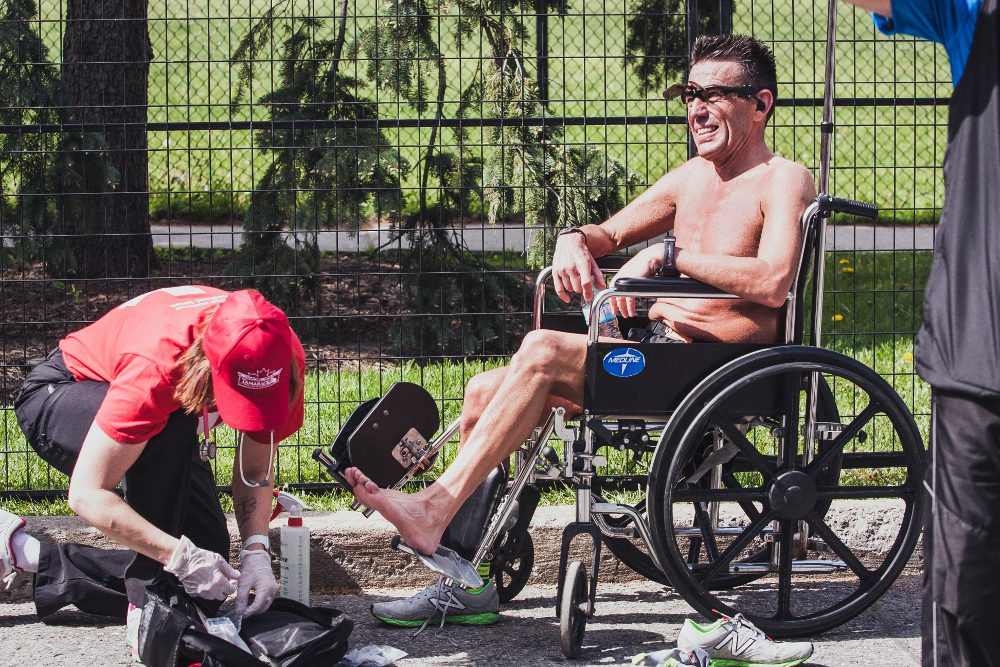When your blisters have blisters
A podiatrist advises on preventing and treating massive blisters


By Madeleine Cummings
Blisters don’t tend to rank high on runners’ injury severity index.
They pop up all the time on our heels and toes. Though these dime-sized guys can cause a little discomfort, they are nothing antibiotic cream and a day in sandals can’t fix.
Unfortunately, my blisters put garden-variety blisters to shame. (They also cause me shame whenever they are accidentally exposed.) As a forefoot striker whose feet twist ever-so-slightly upon impact, I subject my toes to a punishing amount of friction over the course of any distance race.
RELATED: Seven types of blisters that will haunt you if you keep running hard.
Sometimes I can emerge from a race relatively unscathed, with burning feet and bumps that go away on their own. But eventually, I’ll develop large blisters that stretch across the entire ball of each foot. Over the course of a season, I’ll develop blisters on blisters. These can be so painful to walk on that I hobble around the house on my heels and cross-train until they have healed. Back in high school, I skipped my provincial 1,500m final because my blisters ripped open and bled during the preliminary race.
According to Dr. Richard Mandal, a podiatrist in Alberta who has worked with runners, massive blisters like mine are rare.
Some runners claim they can prevent blisters by sprinkling talcum powder on their feet (to keep them dry) or applying a little Vaseline or Body Glide (to moisturize and prevent skin from cracking), but scientific studies on these interventions have yielded mixed results.
When he worked in Chicago as a co-clinic advisor for the American Running and Fitness Association, people came to him with the worst blisters in late August or September – about a month before the Chicago Marathon.
“You have to do a considerable amount of mileage to get to that point,” he said.
Determine the cause
Most friction blisters are caused by ill-fitting shoes, Mandal explained. Choosing a racing flat that fits snugly from heel to toe will help ensure the foot does not slip around during a run. If new shoes don’t solve blister issues, podiatrists can help determine whether there is a biomechanical problem at play, like my twisting feet or a tight Achilles tendon.
Prep before taking a step
Blisters can be nastiest during the summer months because of excessive moisture. When runners pour water over their heads at aid stations during races, that water can dribble down the legs and into the shoes, making the situation worse. Some runners claim they can prevent blisters by sprinkling talcum powder on their feet (to keep them dry) or applying a little Vaseline or Body Glide (to moisturize and prevent skin from cracking), but scientific studies on these interventions have yielded mixed results. Moisture-wicking socks and strategically placed insoles are more likely to better prevent blisters from forming.
To pop or not to pop?
Some blisters are tame enough that they will go away on their own. But the massive ones? “You gotta drain it,” Mandal said. Otherwise, the blisters will be too painful to walk on. To safely pop a blister, wash your foot, and use a sterilized needle to prick a small hole into the skin. After draining the fluid, apply an antibiotic cream and make sure to leave the protective layer of skin on.
Don’t freak out
Seeing layers upon layers of my skin flake off all season had me worried I might be damaging my feet over time. Mandal assured me that this is probably not the case. “Unless you have some sort of skin disease or it gets infected, your body can repair itself,” he said.
Madeleine Cummings is a journalist based in Edmonton. She also writes a column for each issue of Canadian Running. This article appears in the magazine’s September & October 2017 issue.


